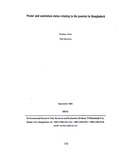Water and sanitation status relating to the poorest in Bangladesh
Citation
Akter, N., & Jakariya, M. (2004, September). Water and sanitation status relating to the poorest in Bangladesh. Research Reports (2004): Health Studies, Vol - XXXVII, 179–189.Abstract
This study aimed to see the level of access to safe water and sanitation and discusses the
knowledge on arsenic contamination in drinking water among the poorest in rural
Bangladesh. This was a part of baseline survey for CFPR/TUP. Household survey method
was used to collect information through structured questionnaire. The survey was conducted
during July-September 2002 in Rangpur, Kurigram and Nilphamari districts. Variables
considered were safe water and sanitation. Sources of drinking and cooking water, water
quality with regard to arsenic, and knowledge on arsenic contamination were considered
under safe water variable. Type, practice and ownership of latrine was considered under
sanitation. Coverage of access to drinking water for SUP and NSUP of three study districts
was above 96% which is similar to national rural water supply coverage (97%). Nevertheless,
most of the households did not have their own tubewell and did not guarantee safe drinking
water. It was also found that about 87% of the households drank water from tubewell those
were not tested for arsenic contamination. Sanitation coverage of the study households was
5.4-9.4%, much lower than national sanitation coverage for rural area (30% or 4 1% including
pit latrines). Lack of awareness along with unavailability of resources are some causes of poor
water and sanitation coverage for the poorest. Raising awareness on safe drinking water and
sanitation as well as ensuring safe drinking water and sanitation access to these districts need
immediate attention to ensure and secure their healthy and sustainable livelihood.

